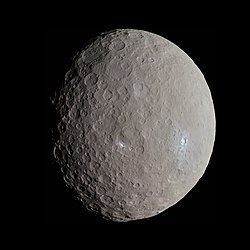Ceres (dwarf planet)
dwarf planet in the Solar System and largest asteroid of the main asteroid belt From Wikipedia, the free encyclopedia
Remove ads
Ceres, also known as 1 Ceres (symbol: ![]() ),[12] is the smallest dwarf planet in the Solar System and the only one in the main asteroid belt.
),[12] is the smallest dwarf planet in the Solar System and the only one in the main asteroid belt.
It was discovered on 1 January 1801, by Giuseppe Piazzi,[13] and is named after the Roman goddess Ceres, as the goddess of growing plants, the harvest, and motherly love. After about 200 years from its discovery, the International Astronomical Union decided to upgrade Ceres from an asteroid (or minor planet) to dwarf planetary status in 2006.
With a diameter of about 950 km, Ceres is by far the largest and most massive object in the asteroid belt, and has about a third of the belt's total mass. It was once thought to be smaller than Vesta, which is brighter. The asteroid is spherical, unlike the irregular shapes of smaller bodies with lower gravity. At its brightest it is still too dim to be seen with the naked eye.[14] Ceres is located at 2.8 AU (257 million miles) from the Sun, which makes it the closest dwarf planet to the Sun. It is also the only dwarf planet in the Solar System that has no moons.
On September 27, 2007, NASA launched the Dawn space probe to explore Ceres and Vesta. In 2015, Dawn became the first spacecraft to visit a dwarf planet, arriving at Ceres a few months before NASA's New Horizons spacecraft visited Pluto, another dwarf planet.
Ceres has an unusual crater, Occator which contains bright salts.
Remove ads
Images

Related pages
References
Wikiwand - on
Seamless Wikipedia browsing. On steroids.
Remove ads

